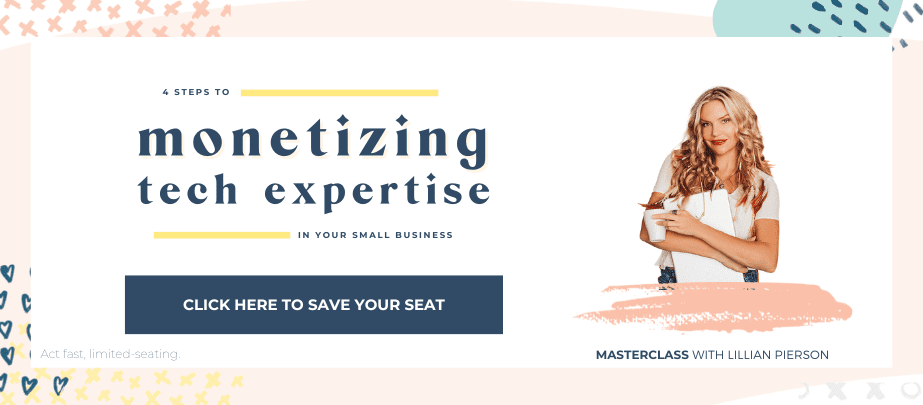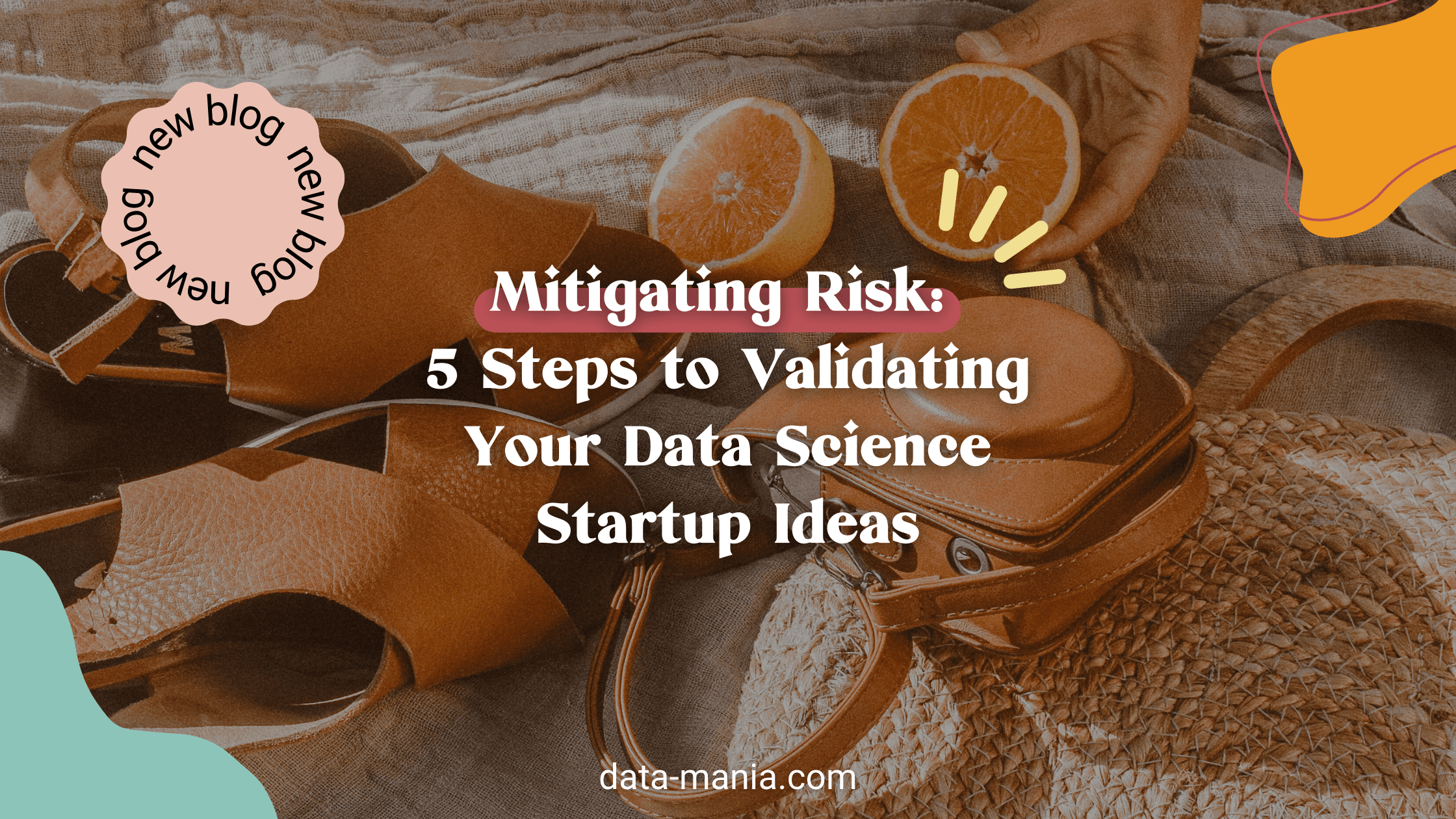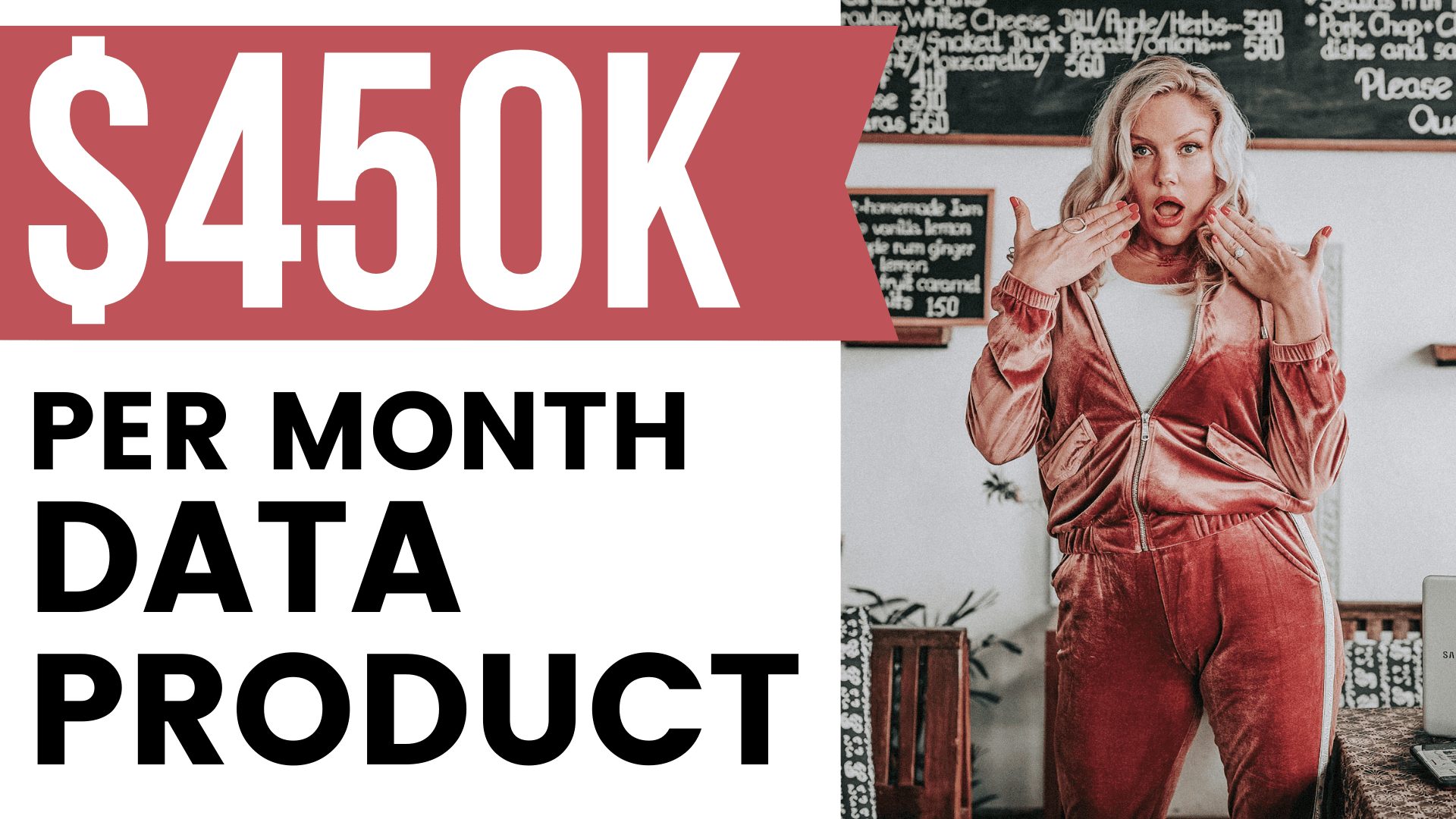
Follow me on:
Before I begin, let me clarify one thing…
You don’t need to be a “hustler”, a “smooth talker”, or anything like that. You just need to take a pragmatic approach to reverse-engineering your way into high-ticket sales, and I’m about to show you how to do just that.
Every person CAN make high-ticket sales for their tech startup by doubling down on these 5 customer acquisition pillars. You don’t even need to be a “hustler”, a “smooth talker”, or anything like that. You just need to take a pragmatic approach to reverse-engineering your way into high-ticket sales, and I’m about to show you how to do just that.
Oh yeah, and this post is going to be loooonnnggg – so if you want to jump around, here is a menu you can use to do that:
Looking for something specific? Scroll straight to what you're looking for by clicking a link below:
- Defining “High-Ticket” In High-Ticket Sales
- High-Ticket Services
- High-Ticket Products
- 5 Essential Customer Acquisition Pillars You Need To Start Scoring High-Ticket Sales
- 1. An Appropriate Offer
- 2. Appropriate Pricing
- 3. A Clear Unique Value Proposition
- 4. Clear Marketplace Needs
- 5. Know, Like & Trust
1st Things 1st: Defining “High-Ticket” In High-Ticket Sales
Pricing is heavily dependent on what’s actually being sold, right? Therefore, it follows that you cannot define “high-ticket” pricing tiers or a feasible customer acquisition strategy, unless you first clarify the offer you’re looking to sell.
Let’s look at some typical “high-ticket” pricing for products versus services.
High-Ticket Services
Technical services come in all shapes and sizes. Let’s look a bit at what bigger companies are offering and then take a peek at how bootstrapped tech founders are doing things.
Examples of services commonly offered by large tech companies
Examples of high-ticket sales in technical services include:
- Custom software development services: Services like this can range from $5k to $10k for a small application, all the way up to $2 MM+ for a large enterprise system.
- Network and infrastructure consulting projects: This type of consulting project can include designing and implementing a new network for a business and can cost over >$20k for starters.
- Cybersecurity consulting projects: Consulting projects like these can include penetration testing, vulnerability assessments, and incident response planning and can cost hundreds of thousands of dollars.
- Cloud migration projects: This type of project can include moving a business’s data and applications to a cloud computing platform and can cost hundreds of thousands of dollars.
Oh, and if the cloud migration project idea piques your interest, you’d probably get a lot out of this free training I did on how to build an evergreen data migration strategy.
It should be noted that these prices are just rough estimates and will vary widely depending on the specific project and the company providing the service.
It’s also important to note that these services might be provided on an hourly basis or a retainer basis (meaning that the client pays a fixed fee on a regular schedule [e.g. monthly] instead of paying according to project milestones or an agreed-upon one-time, lump-sum fee).
A rule of thumb for bootstrapped tech service providers
If you have the expertise, then you can really offer all the same services that are described above, even as a new tech startup founder.
You’ll probably be charging less per project than those companies though, simply because of the project scale that’s typical for small and medium sized businesses.
👍 A good rule of thumb for high-ticket sales pricing for small service-based tech startups is just this: If you’re earning over $300/hour for tech implementation services, or over $500/hour for tech leadership / consulting services, then you can safely say that your customer acquisition and pricing is within the “high-ticket” range for your services.
At a bare minimum, if you’re just starting out as a tech startup founder, a basic rule of thumb I always preach to my clients is:
👍 If you’re earning over $300/hour for tech implementation services, or over $500/hour for tech leadership / consulting services, then you can safely say that your customer acquisition and pricing is within the “high-ticket” range for your services.
High-Ticket Products
We’re all techies here, right? So, when we talk about products in tech, most people assume we’re talking about SaaS products.
While that’s a natural conclusion to draw, there are actually quite a few different product types that tech startup founders can monetize.
For example:
– SaaS (Software as a Service) Products
– Engineered Equipment Products
– Digital Information Products
I’ll quickly give some examples of each below.
Examples of high-ticket SaaS (Software as a Service) products
Examples of high-ticket SaaS (Software as a Service) products include:
- Enterprise Resource Planning (ERP) systems: These can include financial management, supply chain management, and human resources management functionality. These types of systems can cost several thousand dollars per month or more depending on the size and complexity of the installation.
- Customer Relationship Management (CRM) systems: These can include sales force automation, marketing automation, and customer service functionality. You can easily sell access to these systems for well over $1k/month, depending on the size and complexity of the installation.
- Supply Chain Management systems: These systems can include inventory management, logistics management and demand planning functionality. You can easily sell access to these systems for well over $1k/month, depending on the size and complexity of the installation.
- Marketing Automation Platforms: These platforms can include features like email marketing, lead generation, and analytics. You can easily sell access to these systems for well over $200/month, depending again on the size and complexity of the installation.
- Business Intelligence Platforms: These platforms can include features like data visualization, data warehousing, and big data analytics. You can easily sell access to these systems for well over $1k/month, depending on the size and complexity of the installation.
It’s important to note that these prices are just rough estimates and can vary widely depending on the specific product and the company selling it. And also, it’s important to remember that these products might be sold on a usage-based pricing model or as a customized package that fits the client’s needs.
Examples of high-ticket engineered equipment products
Examples of high-ticket engineered equipment products include:
- Industrial equipment: This can include manufacturing equipment, medical equipment, and scientific instruments. These can cost well over $300k, depending on the specific product and application.
- Custom hardware: This can include specialized computer systems, electronic devices, and scientific instruments. These can cost well over $300k depending on the complexity and functionality of the product.
- Military equipment: This can include weapons systems, aircrafts, and vehicles. These can cost well over $10 MM depending on the type and complexity of the equipment.
It should be noted that these prices are just rough estimates and can vary widely depending on the specific product and the company selling it. And it’s important to remember that these products might be sold on a subscription basis or as a financed product within a lease or a loan structured.
Examples of high-ticket digital information products
This category is ideal for all the bootstrappers out there. You can pre-sell these products and monetize them quickly (with high-profit margins) in a new tech startup, even if you don’t have or want investors.
The basic rule of thumb I follow here is, if you can earn at least $1000/hour for the time you invest in building, marketing and delivering a digital information product, then that product falls into the “high-ticket” category. That’s after you subtract out product development costs that also went into building the product though, of course.
This type of product can usually be scaled so each product doesn’t actually require 1 customer to pay a lot of money, but you’re still able to earn a pretty decent return on investment for the time you spent on product development and marketing…
Ok, now that we’re clear on what qualifies as “high-ticket” in high-ticket sales, let’s dig into the meat and potatoes.
5 Essential Customer Acquisition Pillars You Need To Start Scoring High-Ticket Sales, Almost Overnight
When most people hear the words “tech startup”, they automatically envision a VC-backed SaaS startup that is working hard to justify its next funding round.
What they don’t usually envision is a highly profitable tech startup that’s heavily focused on customer acquisition and high-ticket sales. Why? Well, because most tech startup founders don’t have strong backgrounds in business, marketing, and customer acquisition to be honest. If that’s you, fret not – the skills can be learned or delegated.
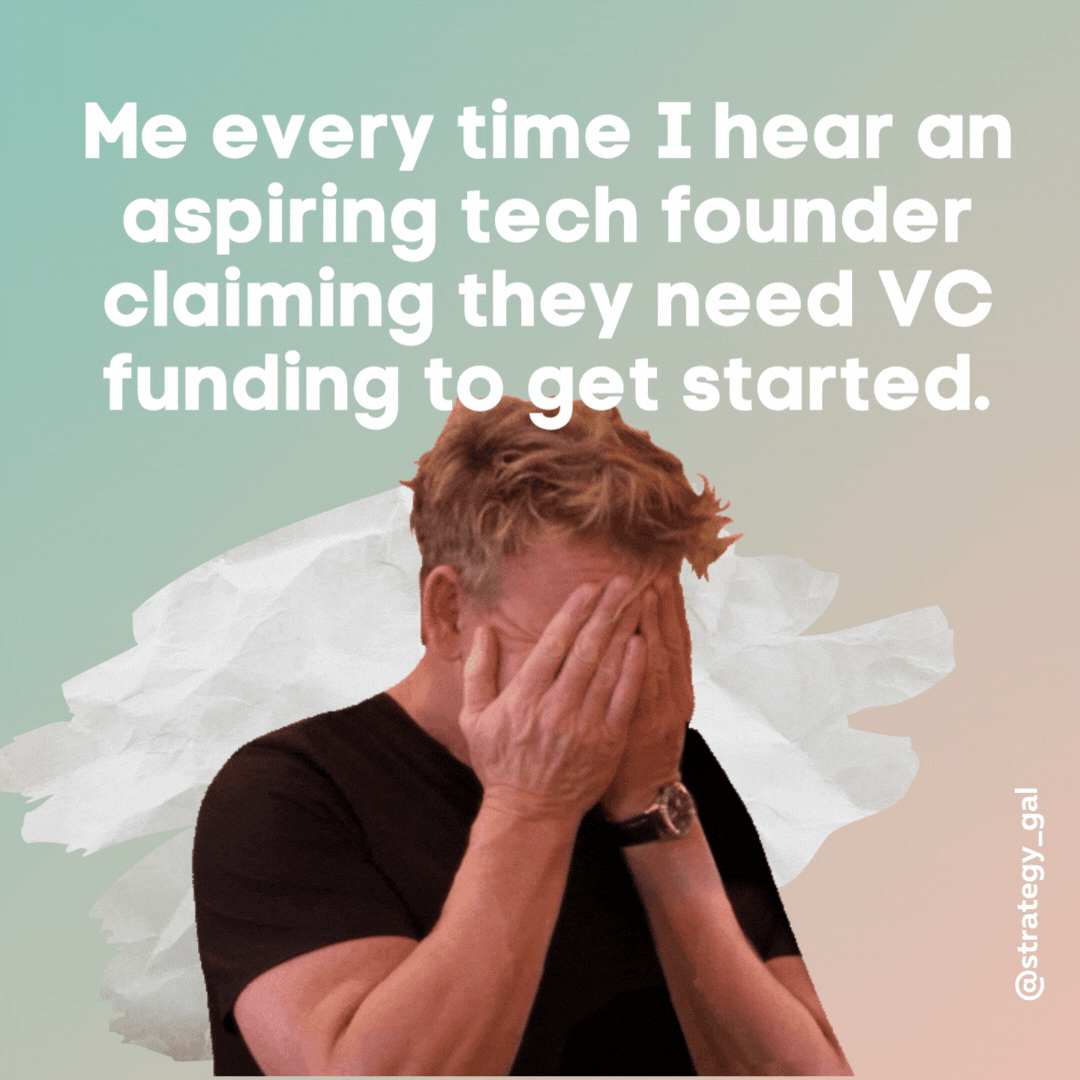

“Not only is VC funding NOT a necessity – for new and aspiring tech founders, investor funding is likely to harm your chances of business success & profitability.”
But I’m here to tell you today, not only is VC funding NOT a necessity – for new and aspiring tech founders, investor funding is likely to harm your chances of business success & profitability.
Why? Well, because most VC-backed tech startup founders focus way too heavily on the tech that they’re building without ever looking at the market, its customers or which customer acquisition strategies are most appropriate.
It really doesn’t matter how brilliant a developer or CTO you are, if you build something no one needs or wants, customer acquisition is highly unlikely, and your project is destined to fail.
On the other hand, when you’re a self-funded startup founder, you don’t have the luxury of making that mistake. You have to figure out how to sell products or services people need or else you won’t make any money and your fledgling tech startup will fail.
If it’s not profitable it’s not a business, it’s a hobby.
So, what are the 5 essential customer acquisition pillars you need to start scoring high-ticket sales? The come down to the following:
- Appropriate Offer – You need an appropriate offer to sell.
- Appropriate Pricing – That offer needs to be priced appropriately (ie’ “high-ticket” pricing).
- Unique Value Proposition (UVP) – It doesn’t matter whether you’re selling a high-ticket service or product, the offer needs to have very clear UVPs.
- Marketplace Needs – There must be a market for your offer, and people in that market must actually need what you have to sell (ie; it can’t be a “nice to have”)
- Know, Like & Trust – If a person does not know you, like you and trust you – it’s highly unlikely they’ll ever buy a high-ticket product or service from you.
Now that you know what the 5 pillars of customer acquisition are, let’s look at the quickest, easiest ways for you to build them out in your own tech startup.
1. An Appropriate Offer
Let’s start by looking at the basic characteristics of an offer that you can use to generate high-ticket sales.
High-ticket offers are characterized by a high price point and a correspondingly high perceived value. Some specific characteristics of high-ticket offers include:
- High perceived value: High-ticket offers are typically associated with products or services that are perceived to be of high quality, exclusive, or unique in some way. They are often seen as providing significant value or delivering a significant return on investment.
- Highly customized: High-ticket offers are often tailored to the specific needs of the customer or small group of customers. They may involve custom solutions or services that are not available to the general public.
- High level of expertise: High-ticket offers often require a high level of expertise or specialized knowledge. They may involve complex products or services that are not easily understood by the general public.
- High-level of support and service: High-ticket offers often include a high level of customer service and support. This may include ongoing maintenance, training, and technical support.
- High-profit margins: High-ticket offers are usually associated with high-profit margins, which means that the company selling the product or service makes a large profit per sale. More on pricing next…
- High-commitment: High-ticket offers often require a high level of commitment from the customer. They may involve long-term contracts or require significant up-front investments.
Overall, high-ticket offers are often considered to be luxury products or services that are only affordable for a select group of customers.
These customers are often willing to pay a premium price for the perceived value, exclusivity, and high level of service and support that high-ticket offers provide.
I’m definitely not one to throw down a bunch of theories and leave you to figure things out for yourself, so let me give you a hand with some ideas for high-ticket offers.
Getting Started With High-Ticket Services
Believe it or not, according to the World Bank, almost 47% of workers worldwide are freelance service providers.
And within the US, tech workers like programmers, data analysts & mobile developers earn average annual salaries of up to $120,000 via freelancing alone (according to Upwork)!
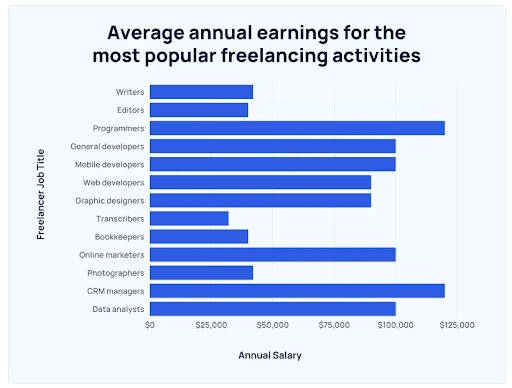

Source: Upwork Freelance Marketplace
Of course, most freelance service providers on Upwork are not making high-ticket sales on their service packages (to the contrary, Upwork tends to encourage a race to the bottom).
Pros vs Cons of the Service-Based Tech Startup Model
🛑 I feel it prudent to stop right here and define the pros and cons of starting / running a service-based business. Even when you’re generating high-ticket sales off the back of your service offer, it’s not always gravy. It’s best you understand these before deciding to pursue this route.
- Low barrier to entry: All you need are skills and expertise to start selling services on the open market, sometimes not even that many of them either.
- Low time & cost to market: Compared to products-based businesses, services take almost no time or cost to take to market. All you need are the skills, an offer, a market / customer, and a way to get paid. Consequently, services are the fastest way for new tech startup founders to monetize their business and start building a customer base.
- Recurring revenue: When done well, services are typically provided on a recurring basis, which can generate a steady stream of income.
- High profit margins: Services can often be sold at a premium price, resulting in high profit margins.
- Low overhead costs: Services typically require fewer resources than products, resulting in lower overhead costs.
- Intangible value-adds: Services are often intangible, which can make it difficult for customers to understand the value they are getting, hence the need for a clearly articulated offer.
- Difficult to scale: Services are often labor-intensive and can be difficult to scale. Unless you want to build a entire services agency, you’ll eventually need to switch business models in order to keep growing your business.
- Time-intensive: Services take man-hours and are mainly delivered in a 1-on-1 format. Spending your time selling, administering, and delivering services will dramatically erode the amount of time you have available to work on growing and improving your own business.
12 High-Ticket Sales – Service Offer Ideas
To help you get started in picking the right offer for use in generating high-ticket sales, I put together a list of ideas for services you can offer to increase your chances of signing high-paying clients.
These services include:
- Systems Starter Audits
- Technical Strategy Services
- Data Cleaning Services
- Software Development Services
- Machine Learning Model Building Services
- Data Visualization Services
- CRM Management Services
- Data Pipeline Construction & Maintenance Services
- Custom Chatbot Services
- Cloud Data Migration Services
- Tech Career Coaching Services
- Tech Training Services
Basically, any technical skill you provide to an employer can be repurposed into a high-ticket service package and sold on the open market to startups or to anyone who is looking to hire external freelancers or consultants.
I actually did a video on this exact topic a few years back for the AI startup founders I was working with. If you’d like to watch that now, I’ll leave that for you below.
YouTube URL: https://youtu.be/BTFnkghunps


Quick Example: Impromptu selling of tech expertise through a high-ticket service offer
If you speak to healthcare leaders today, you’ll find that a good percentage of them have access to a hiring budget to get their internal data storytelling needs met…
People with access to a decent budget will NOT want to buy a course or a book on the topic in order to take the DIY route. Obviously, who has time to waste struggling to get DIY results if you have the option of hiring an expert to get fab results served up without any time or effort whatsoever?
No, most of these healthcare leaders would greatly prefer to pay someone a fair rate to come in and serve them up a data storytelling solution on a silver platter. They’re likely interested in the quick win and the credit they’ll get for scoring it.
So, if you were to find yourself in an impromptu conversation with a person like this inside of your LinkedIn DMs, and you had data storytelling expertise, that conversation would be a good opportunity for you to offer and sell them a high-ticket data visualization service package.
On the other hand, if you make the mistake of offering this person a book or a training service so they can DIY, they’re not likely to be impressed with that idea.
What’s worse, once you’ve extended the person an irrelevant offer, it’s likely that you’ve lost most of the trust and credibility they’d been extending you. Consequently, it’s unlikely they’ll want to buy anything from you later – even if you try to raise the possibility of you doing a done-for-you service.
Story: How I used service offers to quickly get my tech startup off the ground
Like many new entrepreneurs, I offered services to get my business up off the ground and generating a profit back in 2012. I’ve since incorporated a variety of business models into Data-Mania, but here is a quick rundown of how I got started as a tech startup founder.
I started blogging about data science back in 2012. To be honest, I am not sure how “awesome” my blog was back then, but it quickly reaped me the following benefits:
- Paid freelance jobs in 2012 – Multiple solicitations found their way to my inbox from editors asking to pay me to write blogs on data for their big-name websites.
- Sponsored content jobs in 2012 – Big businesses (like IBM, for one) began emailing me telling me that they will pay me to write and publish a sponsored post on the data topic of their choosing.
- Consulting leads started rolling in by 2013 – United Nations staff emailed me asking for my technical consulting services because they had seen my blog post related to humanitarian deployment and spatial intel.
A blog can be just the boost you need to start making sales in a new business, even high-ticket sales if you know how to pull that off.
Back in 2012, I didn’t have an article like this to tell me how to do customer acquisition or high-ticket sales. I had no idea about anything related to marketing, startups, etc… to be honest. So, I winged it and got subpar results.
The reason I am publishing this article now is so that you don’t have to waste your valuable time figuring all this out from scratch and can instead get started right away with acquiring high-value customers.
Products Are Also A Possibility For New Tech Startups, BUT…
If you’re like most tech startup founders, then you’re obsessed with the idea of building and monetizing via a scalable product.
I can’t lie, I love product too – but there are significant financial risks associated with building a product and bringing it to market. You need to know how to mitigate those risks before attempting to do it, and I don’t have space in this blog for that whole topic, so…
“If you’re a brand new founder and you don’t have an audience / market… if you don’t have access to a community of people who trust you, who’ve clearly stated that they have a problem that you know your product can solve… you’re best off not building any product at all.”
Just know, if you’re a brand new founder and you don’t have an audience / market… if you don’t have access to a community of people who trust you (more on that later), who’ve clearly stated that they have a problem that your product can solve… you’re best off not building any product at all.
One of the biggest mistakes new tech founders make is that they build a product for no one, then when it’s done, they have no one to sell it to and that product doesn’t actually solve a need in the marketplace.
In all honesty, I don’t understand why VCs continue enabling this common failure by giving money to “founders” who don’t have a market or a customer base, but hey…. If you know the answer, I’d love it if you’d tell me about it in the comments below.
If you’re reading this, I’m assuming you’re a pretty new founder or startup leader… and so, to reduce the risk of you making this ^^ overwhelmingly prevalent mistake, I’ve decided to leave product ideas out of this post.
2. Appropriate Pricing
We’ve already discussed pricing quite a bit earlier in this post, but I’ll add a bit more on to that by discussing why you need to price your high-ticket service appropriately.
Pretty soon after your customer acquisition rates ramp up, you’ll probably want to specialize so that you can become seen as the go-to expert for that service – and so that you can start commanding higher rates for your tech services.
When clients hire experts, they expect to pay higher prices. If you set prices that are too low, potential customers will quickly assume that either:
A. You don’t know the value of your own expertise or
B. Your offer isn’t all that great
Neither of the above scenarios is good for you or your fledgling tech startup, especially since it’s pretty simple to price out high-ticket services and adjust them later, after you’ve delivered the package a few times.
Inside my Data Creatives & Co. Course, I provide new tech startup founders with a plug ‘n chug Set-Your-Rate Calculator. Here is the example I provide them within that:
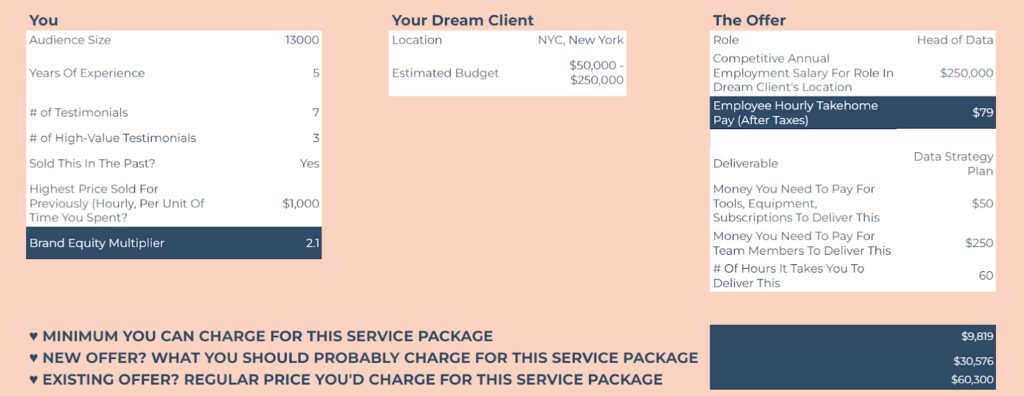

As you can see, brand equity plays a big part in how much you can charge for your tech services. The variables that comprise brand equity can be boiled down to:
- Your experience level
- Your audience size (related to that area of expertise, of course)
- The number of testimonials you have
- The number of times you’ve achieved this service-based transformation for customers in the past
- The highest price you’ve sold your time for in the past (related to that area of expertise, of course)
Other important factors to consider are:
- Location where your ideal client lives
- Budget that your ideal client has for the work
- Delivery costs you’ll incur
- Contractor costs you’ll incur
- The number of hours it will take you to deliver the service
Hopefully the above will give you a head start on pricing your service package after you’ve picked it out.
3. A Clear Unique Value Proposition
A unique value proposition (UVP) is a statement that clearly and concisely communicates the unique benefit or value that a product or service provides to its customers.
It’s a key element of a company’s marketing strategy and should be used to differentiate the company’s offerings from those of its competitors.
A UVP should be specific, measurable, and differentiable from other similar products or services.
6 Steps To Defining A UVP For Your Offer
There are 6 steps to defining a unique value proposition:
- Understand your target customer: Start by identifying your target customer and their needs, wants, and pain points. This will help you to understand how your product or service can provide value to them.
- Identify your competition: Research your competition to understand their offerings and how they position themselves in the market. This will help you to differentiate your product or service from theirs.
- Identify your unique selling points: Determine what makes your product or service unique and what value it provides to customers. This can include features, benefits, or other aspects that set it apart from your competition.
- Craft your UVP statement: Use the information you have gathered to craft a clear and concise statement that communicates the unique value of your product or service.
- Test and refine: Once you have a UVP statement, test it with potential customers to see if it effectively communicates the value of your product or service. Adjust as needed.
- Communicate your UVP: Use your UVP in your marketing and sales efforts to communicate the unique value of your product or service to potential customers.
Now that you know how to define a UVP for your offer, let’s look again at our data storytelling customer acquisition example.
Example, Continued: Back to our data storytelling services example
There must be some topics, sub-disciplines, specialties or offers in the tech space that you’re SUPER SICK of hearing everyone else talk about.
For example, “data storytelling” is super popular right now among people who specialize in data. It is not a good time to start a course and teach people data storytelling, and here’s why:
🚫 Competition: You’ll have way too many competitors trying sell the same exact transformation “ie; learn how to do data storytelling” to a small market of buyers. In other words, the market is (over?) saturated with suppliers. Because “everyone else” is already doing it – it’s definitely not a unique offer, so positioning it as unique won’t be that easy.
🚫 Your unique selling points: Unless you’re a published author on the topic or have built up some other significant credentials that demonstrate why you’re the go-to expert on data storytelling, you probably don’t have much of an unfair advantage in trying to sell a data storytelling information product. In other words, compared to top competitors in the market, you would need some very compelling selling points in this case.
That doesn’t mean you should give up your dreams of creating an impact through data storytelling though. What it means is that you need to do more work on your offer… to make it more compelling.
One thing you could do is take those “data storytelling” skills of yours and dial them down to support the very specific needs of one unique client avatar. In other words, you could tailor your offer to your “target customer”, a very specific class of professionals who really need the type of data storytelling help you have to offer!
One alternative could be to generate high-ticket sales from a services offer that support the needs of healthcare leaders, like we discussed in our example earlier.
4. Clear Marketplace Needs
Marketplace needs refer to the wants, desires, and pain points of customers in a specific market or industry. Understanding marketplace needs is crucial for developing products or services that will meet customer demands and be successful in the marketplace.
You need to make sure that your customers need whatever it is that you sell – either products or services. It can’t be just one of these things that’s nice to have – it really needs to be something that solves a problem for them and that it is an urgent necessity that will require them to actually make that purchase.
It’s important to note that marketplace needs can vary depending on the industry and target market, so it’s important to conduct research to understand the specific needs of the marketplace you’re targeting.
When conducting that market research, look for the huge gaping holes in the market that you have the expertise to fill. Look on job boards, freelance marketplaces, look inside Facebook Groups, Quora, Reddit or anywhere else where people are reaching out for help on your area of expertise. These are the pockets of demand where customer acquisition is likely to be easiest, provided that there are not too many suppliers already in the market,
By looking at how people are asking for help in terms of job postings or questions, you can get a pretty good idea of their level of urgency, and you can also see the degree of market saturation in terms of other service providers filling those requirements.
5. Last But Not Least: The Know, Like & Trust Factor
The “Know, Like, and Trust” factor (KLT factor) is a concept in marketing and sales that refers to the process by which potential customers become familiar with, develop a positive perception of, and ultimately trust a company or brand.
- Know: The first step in the KLT factor is for customers to become familiar with your company or brand. This can be achieved through various marketing and advertising efforts such as content marketing, social media, and public relations.
- Like: Once customers are familiar with your company or brand, the next step is for them to develop a positive perception of it. This can be achieved by consistently providing value, meeting customer needs, and building relationships with customers.
- Trust: The final step in the KLT factor is for customers to trust your company or brand. This can be achieved by consistently delivering on promises, providing excellent customer service, and building a reputation for being reliable and trustworthy.
The KLT Factor is critical for tech startups because when a customer trusts a brand, they are more likely to become a loyal customer and recommend that brand to others.
Building trust takes time and effort, but it’s an important step in the customer journey, and it can be the difference between a customer choosing your business over your competitors.
There are quite a few ways that you can quickly build up KLT with prospective customers. I’ll give you a few ideas below:
- Offer a low-price, yet highly valuable product or service – Something where they can dip their toe in the water to see what kind of results you can generate for them and then they know they want to keep working with you.
- Generate word-of-mouth referrals – Once you’re generating word-of-mouth referrals, customer acquisition becomes a lot easier. If you have people that you have worked with in the past, even if it’s in an employment environment, and they recommend you for the transformation you made in their business, then it’s going to be a lot more likely that their colleagues will trust you as well and make that purchase from you. To facilitate this, you can deploy automated referral prompts via post-purchase nurture email sequence or even incentivize word-of-mouth referral by way of an affiliate program.
- Credibility – Another way to build trust is the external show of credibility factors. Yes, of course degrees and certificates are great, but in all honesty in the business world, no one cares that much about your degree (unless you went to MIT, Harvard, Stanford or something like that). The big thing you need is great testimonials! If you can get results for people and show those results as proof and evidence of your ability to get results for more people – that’s going to be one of the things that really helps potential clients trust you.
Wrapping Things Up
Now that you’re abundantly clear on the 5 customer acquisition pillars you need in place to start scoring repeatable high-ticket sales for your tech startup, what’s left but for you to take action?
I’ll end this post with an action item assignment and an invitation.
The action item assignment: The challenge I leave you with here today is to go ahead and start building out your customer acquisition pillars by using the resources I provided above to define an appropriate offer for your startup (or future startup).
The invitation: If you made it to this point in the blog post, you’re a good candidate for next steps. That’s why I’d like to invite you to my FREE 75-minute masterclass where you’ll get my 4-step method for successfully repackaging your tech expertise & selling it through a business you own. Sign-up here today.




